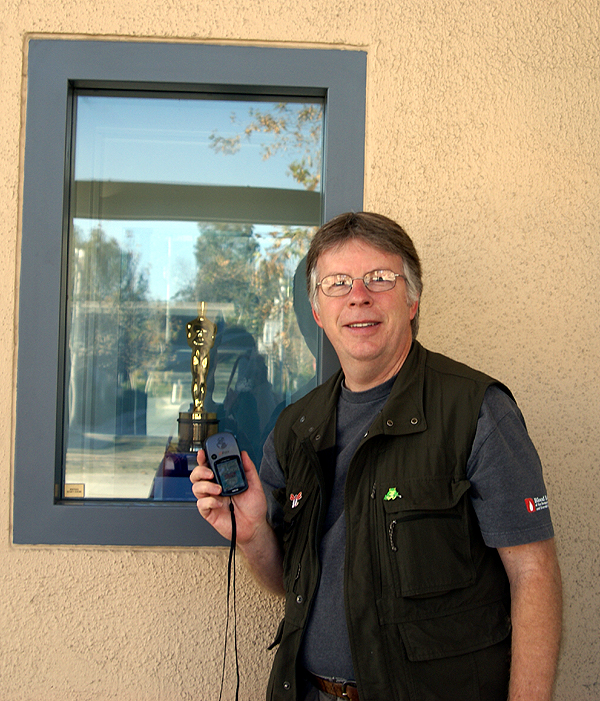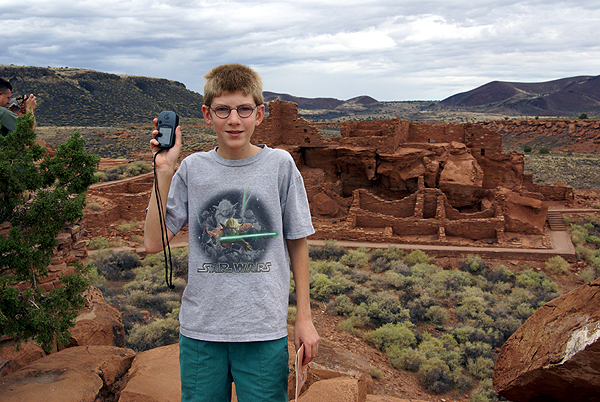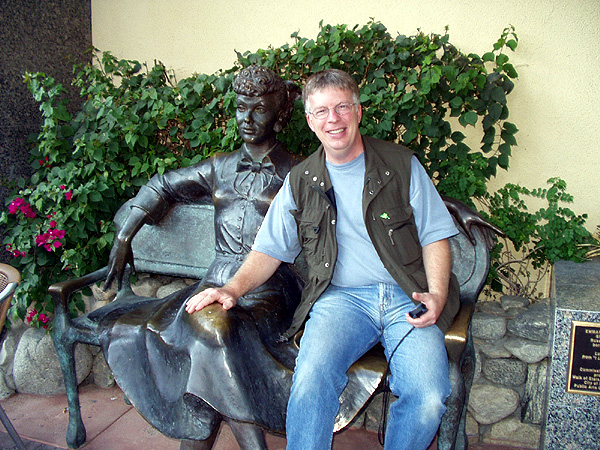
 I have found 67 virtual caches since I started caching back in 2001. Not a lot, but it represents 3.8% of all of my cache finds. Count the couple of Mystery caches which were really virtuals, the one webcam cache that I’ve logged, the earth caches that I’ve found and those pesky locationless caches and some folks would say that about 5% of my cache finds aren’t “real.” And those people would be right, when you consider that you’re supposed to find a cache container when you go out geocaching.
I have found 67 virtual caches since I started caching back in 2001. Not a lot, but it represents 3.8% of all of my cache finds. Count the couple of Mystery caches which were really virtuals, the one webcam cache that I’ve logged, the earth caches that I’ve found and those pesky locationless caches and some folks would say that about 5% of my cache finds aren’t “real.” And those people would be right, when you consider that you’re supposed to find a cache container when you go out geocaching.Does that make virtuals non-caches? It seems that Geocaching.com appears to believe it since they don’t allow virtuals to be listed any more. They have allowed ones that were already created to be grandfathered in to the system. The same holds true for webcam caches. I know, because I own the Blue Jay Webcam cache. I don’t own any virtual caches, mainly because I couldn’t find, what I thought was a suitable location for a virtual. And I think there is where the problem lies with virtual caches. I’m not trying to pat myself on the back for this one, but I think if people had been a little bit more discriminating when they set out to create virtual caches, we might still be allowed to post virtual caches today.
 The principles of a virtual are pretty simple. Instead of a cache to find, you have to find information. You then email the owner of the virtual with that information before you can log the cache. Sometimes, you have to post a current picture of you at the site which will satisfy the logging requirement. Sometimes you have to do both. Most are educational in some way and many are fun and whimsical.
The principles of a virtual are pretty simple. Instead of a cache to find, you have to find information. You then email the owner of the virtual with that information before you can log the cache. Sometimes, you have to post a current picture of you at the site which will satisfy the logging requirement. Sometimes you have to do both. Most are educational in some way and many are fun and whimsical.

 On the other hand, I can also remember several virtual geocaches where, after I’d gone through the motions of doing the required elements to log the cache, I thought, “Eh, that was ok, but couldn’t he have just placed a micro over here, or perhaps she could have set up an offset using some of the information on the plaque?”
On the other hand, I can also remember several virtual geocaches where, after I’d gone through the motions of doing the required elements to log the cache, I thought, “Eh, that was ok, but couldn’t he have just placed a micro over here, or perhaps she could have set up an offset using some of the information on the plaque?”
Some of these virtuals I’ve found, were just plain lacking. The information could have been easily transmitted on the cache page and a real cache could have been hidden at the site. One virtual I found was about an oak tree that wasn’t there anymore. All the history of the tree was on the cache page, so why didn’t the hider just hide a cache there and leave the history on the cache page? Another was a shrine to frogs. Now I love frogs probably just as much as the next cacher, maybe even more, but couldn't the person have found a good sized plastic frog and created a cache with it and then placed it at the frog shrine? That might have been quite a tough cache to find.  Still another virtual, required you to post a picture in front of a house that had, what can be described as pretty tacky landscaping. This particular house was featured in Steve Martin’s movie “The Jerk.” Yet another virtual looked down upon a movie studio in
Still another virtual, required you to post a picture in front of a house that had, what can be described as pretty tacky landscaping. This particular house was featured in Steve Martin’s movie “The Jerk.” Yet another virtual looked down upon a movie studio in
 The one spot where I really think they should still allow virtuals is in our National Parks. In general, National Parks are the epitomy of the “Wow” factor. Since the National Park Service won’t allow traditional caches in the parks, virtual caches fit the bill perfectly. But, with the moratorium, they can’t be placed and I believe that’s a shame. As noted above, I would have missed out on some really interesting local history were it not for some geocaching virtuals. I’m sure it’s the same way for others. How easy would it be for Geocaching.com to make that exception regarding virtuals and allow them to be placed in National Parks again? Unless we, as a community speak up, it won’t happen. I’ve written letters and I hope others will as well. I think the early geocaching community didn’t police itself well enough and now we’re paying the price of no new virtuals. That is a shame, because a good virtual is worth its weight in gold in my opinion.
The one spot where I really think they should still allow virtuals is in our National Parks. In general, National Parks are the epitomy of the “Wow” factor. Since the National Park Service won’t allow traditional caches in the parks, virtual caches fit the bill perfectly. But, with the moratorium, they can’t be placed and I believe that’s a shame. As noted above, I would have missed out on some really interesting local history were it not for some geocaching virtuals. I’m sure it’s the same way for others. How easy would it be for Geocaching.com to make that exception regarding virtuals and allow them to be placed in National Parks again? Unless we, as a community speak up, it won’t happen. I’ve written letters and I hope others will as well. I think the early geocaching community didn’t police itself well enough and now we’re paying the price of no new virtuals. That is a shame, because a good virtual is worth its weight in gold in my opinion.
And the Oscar® Goes To...
Simon Rodia's Dream
Wupatki
Challenger Shuttle Memorial
Luv'n Lucy
Bye Bye Blackbird

1 comment:
Nice article, webbie :-) You know *my* opinion of virtuals; some of the best caches we've found have been virts, and I still think it was a mistake for TPtB to eliminate them. Waypointing just isn't the same thing at all.
Of our exactly 2,000 Finds (as of this post), exactly 50 (2½%) of them have been virts; of the 129 caches that we own, 5 are virtuals (although two of them are listed as multis, as you have to go to several places to get all the info) and all of them are still up and running and getting finds :-) We've had to settle for offsets or puzzles at a few places that we would rather have done a virt, and a few we've just had to leave alone, as there was no realistic way to do a good offset. One of our newest caches (GC15ZRB) is a puzzle/virt.
Among my favorite virtual finds of ours are:
Some like it Hot (GC436A), at Baker, CA;
Space Station Grace (GCG4KD), in Elysian Park in L.A.;
The Snail (GC7BFF), in Venice, Italy, which we found in a heavy rainstorm on our last day in that magical city;
Virtual Stamina (GC3391), near the tiny "town" of Klamath, CA, on US 101;
James Dean (GC804F), in the even tinier "community" of Cholame, CA;
A very unique garden (GCE7C1), in Eureka, CA;
Lost Mission (GCGCJ2), in Lompoc, CA;
Big Critters With Antlers (GC33F5), at Prairie Creek SP, between Eureka and Crescent City, CA;
Tombstone (GCGYWG), at Port Hueneme, CA, and
Atlas (GC3A87), in a cemetery in Hollywood, CA.
One of the more unusual virts we "found" was What in the World (GC6D43). You can log it at your computer without getting out of your chair, if you know what how to find what you are looking at ;-)
While I agree with you that a number of virts are a trifle lame, the same can be said about a huge number of physical caches (a point which you have made in your cache logs on more than a few occasions), so I really don't think that this is a valid argument for not having them anymore. I think that GC just bowed to the pressure from a strong block of cachers that a cache should be something physical, with a log to sign. Hard to argue against this, but considering that they broke off waypointing into its own area, one would think that they could have done the same with virtuals; I assume that they just think of *all* waypoints as virts, and left it at that. I disagree, but then, that's my right, just as it is theirs to do what they want with their website. If we really don't want to play the game anymore, we can stop any time, and save $30 a year. Right ;-)
As for why some sites, such as the Frog Shrine, don't have micros disguised to fit in, I think that that just would encourage people to mess around with the place. Too many cachers are environmentally and culturally ignorant as it is without giving them even more reason to be dolts :-(
As for National Parks, we still have EarthCaches, which the NPS are positive about, in general. The trick is to find a good "hook". In many NPs, local history can be melded with geology quite easily; I'm working on a couple of ideas in this regard for the Santa Monica Mountains National Recreation Area.
Post a Comment